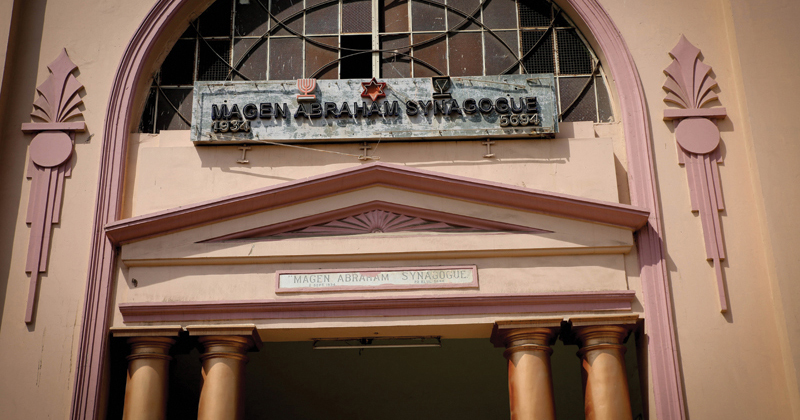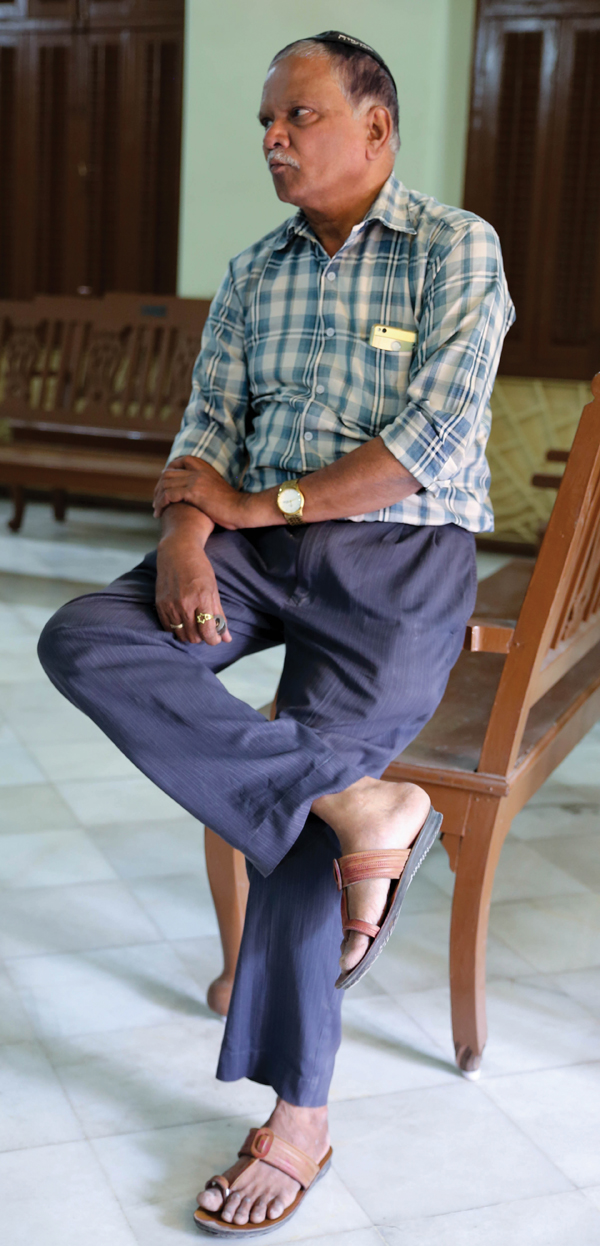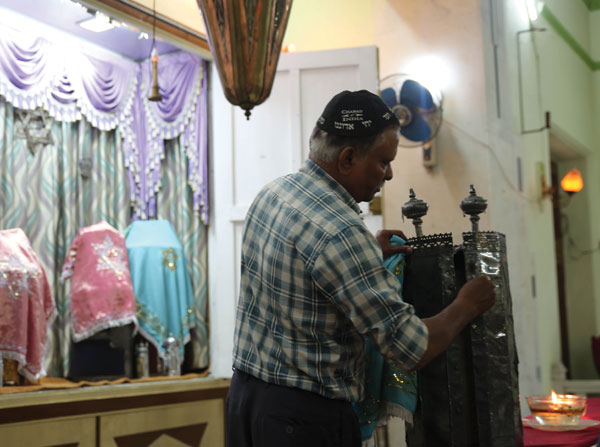
lives
KABBALAT
SHABBAT IN
KHAMASA:
THE JEWS OF
AHMEDABAD
by DAVID IAN KLEIN
A HMEDABAD, INDIA — On a Friday springtime evening in the old bazaar in this busy city in India’s western state of Gujarat, the sounds of Hebrew prayer drift out of the open doors of the Magen Abraham Synagogue. The sounds quickly get lost amid the congested byway, mixing with the calls of street vendors hawking their wares and the chug-chug of auto-rickshaws making their way through the streets. But the Hebrew prayers are a sound worth paying attention to. They come from the only synagogue in the entire state of Gujarat.

With a population of more than 5 million, Ahmedabad is the fifth largest city in India. The state of Gujarat, whose northwest corner borders Pakistan and whose peninsula juts out into the Arabian Sea, boasts more than 60 million people. Compared to those numbers, the Jewish community of 140 is just a tiny drop. Nonetheless, the community frequently manages to get a minyan. On this particular night, 14 local Jewish men — 10 percent of Ahmedabad’s Jewish community — plus three foreign guests turned out to welcome the Sabbath with a spirited Kabbalat Shabbat service.
Despite the isolation of this community, Kabbalat Shabbat in Ahmedabad doesn’t look much different than it does in Conservative or Modern Orthodox synagogues elsewhere in the world. There is no mechitzah separating men and women, but the two female guests who came for Friday night services sat on the other side of the aisle. While the community has siddurim, courtesy of the American Jewish Joint Distribution Committee, the service is much like it was laid out in the 16th Century when it was established by Kabbalists in Tzfat.
Worshipers swayed back and forth during the Amidah prayer. At one point, a prayer was sung to the tune of Hatikvah, the Israeli national anthem.
After the closing of the Ma’ariv service, some hints of the Indian Jewish tradition were more evident. One unique feature of Indian Jewish communities is the veneration of the prophet Elijah to an extent well beyond the level of other diaspora communities. The men lined up after davening to kiss the synagogue’s Chair of Elijah and then stood before the ark, where they said their own personal supplications in a way not dissimilar to puja, a daily personal prayer practiced by Hindus.
“We are Indians and there is an Indian effect on us, naturally there should be,” said Benson Enoch Argwarker, a member of Ahmedabad’s Jewish community.
Argwarker laments that most of his generation does not speak Hebrew. One man serves as chazan for all of the community’s needs, whether it is Friday night davening, weddings, bar mitzvoth, or funerals. However, Argwarker is hoping to change that. The chazan has organized a class on Sundays which is attended by members of the community of all ages. Four young boys from the class have even become fluent enough in Hebrew to daven and read from the Torah for the community. “He is doing it out of love for the community and love for the synagogue,” said Argwarker.
Ahmedabad’s Jews are part of a community that has been native to the Indian subcontinent for nearly two millennia. Though there are many distinct Jewish groups in the country — the result of several periods of migration to the Indian subcontinent — there are three main groups. Cochin Jews, who came to the city of Cochin in Kerala possibly as far back as biblical times; Baghdadi Jews, who fled Iraq in the 1700s; and the Bene Israel community, who make up the majority of Ahmedabad’s Jews. According to tradition, the first Bene Israel Jews arrived in India in the wake of the Second Temple’s destruction, on a ship that wrecked off the coast of Maharashtra. There they stayed, settling in villages and later in the city of Mumbai.
Unlike the Jewish centers of Europe, the Middle East and North Africa, Jewish life in India was relatively peaceful for thousands of years. “We as Indian Jews very proudly say that, until this date there has been no discrimination, no anti-Semitism, no persecution against Jews in India. Perhaps the only country in the world,” said Argwarker.
Khamasa, the neighborhood around the synagogue, is a picture of diversity and tells the story of that spirit of tolerance. Across the street is a Zoroastrian fire temple. Around the corner is Ahmedabad’s Jama Masjid, or grand mosque, and only a little farther away are a Christian church, a Hindu mandir, and a Jain temple.

Jews first rose to prominence in India in the oil pressing industry. The lore about them is that they would not perform their trade on Saturdays, which paradoxically gave them a nickname. “Saturday in Marathi is called Shanivar, so they came to be known as Shanivar telis, Saturday oil pressers,” explained Argwarker.
Bene Israel Jews first came to Gujarat from the Maharashtra coast in the mid-19th Century and most still speak Marathi in the home rather than Gujarati, the local language. With the arrival of the British in India, Jews became prominent in the British army, and followed the construction of British railroads to Ahmedabad.
The Magen Abraham Synagogue was built in 1934 and was named after Dr. Abraham Erulkar, one of the first Jews to come to Ahmedabad and the father of Solomon Erulkar, who put up the money for the project. It is an Art-Deco-style building and rises high above the surrounding houses and shops. The women’s balcony on the second floor, no longer in use, harks back to a time when the community was much larger.
In the late 1940s there were over 30,000 Jews in all of India, according to a study by the American Jewish Joint Distribution Committee that assesses the world Jewish population after the Holocaust. However, with the end of British rule in 1947 and the establishment of the State of Israel less than a year later, mass migrations led to a steep decline in the country’s Jewish population. Today there are only about 5,000 Jews in India, 3,500 of whom reside in Mumbai, according to the Jewish Virtual Library. In contrast, there are over 80,000 Jews of Indian descent who reside in Israel, according to The Times of India.
When asked why a small remnant chose to remain in Ahmedabad, Argwarker explained, “We have been born and brought up here. Our culture, of course we call it Judaism, but when we go and settle down in Israel we feel culturally uprooted.”
Over their 2,000 years in India, Jews have flourished if not in number then in business, civic engagement, and the professions. The community of oil pressers became soldiers and later early stars of Bollywood cinema, such as Sulochana, a silent film actress whose birth name was Ruby Myers. In Ahmedabad, Jewish community members are heavily involved in education, and many work in English schools in Ahmedabad such as the Nelson’s and Reubs Higher Secondary Schools, which both have Jewish principals. In addition, Ahmedabad’s beloved zoo and natural history museum was established by Reuben David, and one of the leading scholars in the study of Sanskrit in India was Esther Solomon: both Ahmedabad Jews who were awarded India’s Padma Shri award for their contributions.
“Yes, we have problems, we are not sure what the future has in store for us,” Argwarker said, “but we are keeping the torch of Judaism burning in this corner of the world.” ■
David Klein is a freelance journalist based in New York. He was raised in the Washington, D.C. suburbs and holds a bachelor’s in anthropology from Drexel University and a master’s in journalism from Columbia Journalism School.
PHOTOGRAPHS BY ANA M. SINGH
| PREVIOUS ARTICLE | NEXT ARTICLE |